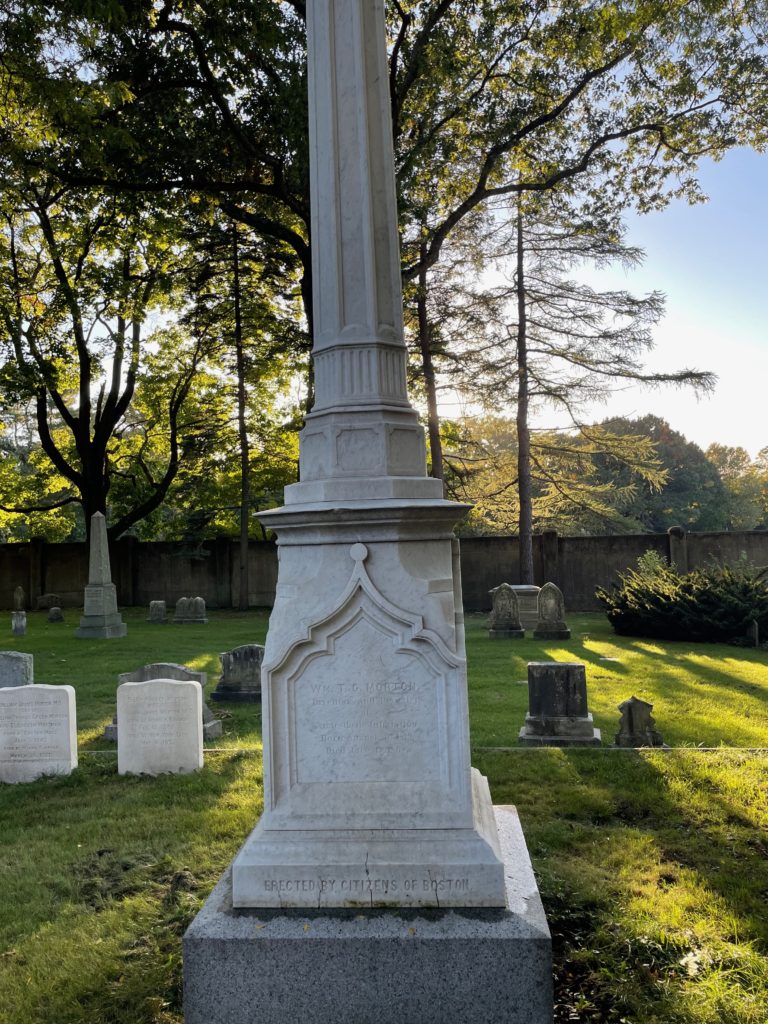Erik Visits an American Grave, Part 1,278
This is the grave of William T.G. Morton.

Born in Charlton, Massachusetts in 1819, Morton was the son of a miner and thus pretty working class. He grew up in the Boston area and floated around in a few careers as a young man before deciding on dentistry. Now, dentistry in the 1840s was…grim. It’s kinda grim now in a way, but it was really grim then. It was just pure pain–some medieval torturer sticking instruments in your mouth, cutting away, maybe you get some whiskey for the pain, but it’s a lot of screaming. I mean, this is not good.
Now, Morton did not stick with this profession either because the woman he married came from an elite Connecticut family (her father was in Congress) and they were not going to let their daughter marry a dentist, which was not seen as a respectable profession at the time. So he agreed to go to medical school and become a doctor, at which point the parents acquiesced. He enrolled at Harvard and took courses on a variety of matters, though he never graduated. But one thing he did take with him was the principles of anesthesia. This was still in its infancy, but Morton was interested. He was still a dentist at heart and to add some sort of anesthetic to dentistry would change the world.
In 1846, Morton performed a tooth extraction on a patient after giving him ether. This was the first time that had ever happened. There was a report on it in a local newspaper and more prominent Boston doctors began trying it. It worked perfectly, or at least better than anything in human history before that. Beat whiskey anyway.
Morton wanted to make bank on this. He did not like the idea that everyone could just use ether now. He tried to hide what it was he used, but that did not succeed. So he tried for the rest of life to get paid for coming up with it. As you can imagine, most doctors and certainly the general public believed that this kind of universal miracle should be spread far and wide. Morton thought it was more important to patent it for his future financial security. But others, including Charles Jackson, the professor who taught him the principles of it at Harvard, thought he was hardly the only inventor of the technique. Morton got his patent but he also received a ton of hate from the world for it. He had something of a reputation of a duplicitous operator in any case and this did not help. He then applied to Congress to get paid $100,000 for his contributions to humanity. Let’s just say Congress was not impressed. He then sued the government. He actually got Richard Henry Dana, the prominent author of Two Years Before the Mast to represent him in court, but that didn’t go anywhere either. He did have his sympathizers–he had come up with a world changing medical technique and had received not a dime for it. So some tried to raise money for him.
In the Civil War, Morton offered his services. The vast majority of wounded soldiers did not have access to any kind of anesthetic except the booze and the leather strap to bite on. But Morton joined the Army of the Potomac as a volunteer doctor and he applied ether to thousands of wounded soldiers before surgery over the next couple of years, including in the madhouse that was The Wilderness, among other horrible battles that were total chaos for the wounded.
In 1868, Morton was driving a carriage in New York when he had a massive stroke and died. He was 48 years old. Upon his death, his wife produced three medals that she said represented his entire compensation for what he had offered the world. His contributions were recognized more upon his death, but even then there were multiple people with legitimate claims to inventing the use of ether. However, we cannot overstate Morton’s contributions to the world, as difficult of a guy as he sounds.
William T.G. Morton is buried in Mount Auburn Cemetery, Cambridge, Massachusetts.
if you would like this series to visit other American surgeons, you can donate to cover the required expenses here. William Stewart Halsted is in Brooklyn and John Heysham Gibbon is in Bala Cynwyd, Pennsylvania. Previous posts in this series are archived here.


